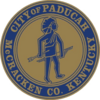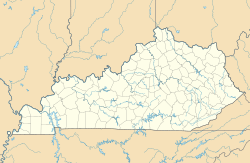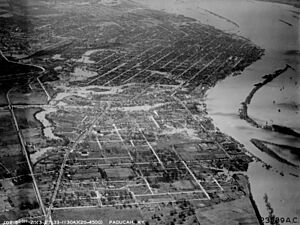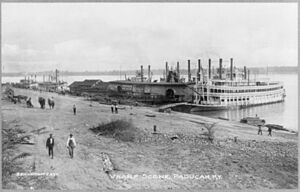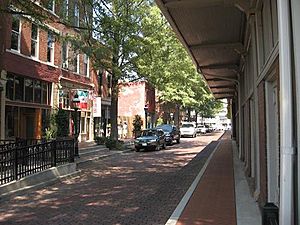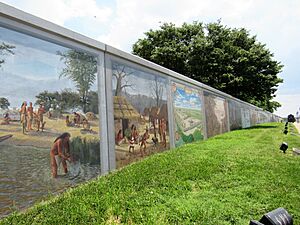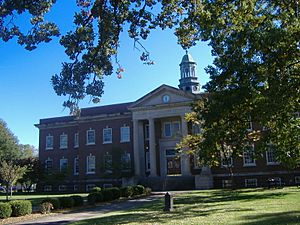Paducah, Kentucky facts for kids
Quick facts for kids
Paducah
|
|||
|---|---|---|---|
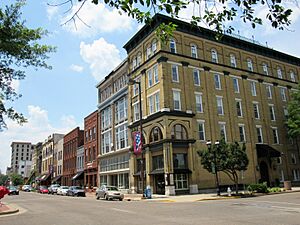
Broadway, in downtown Paducah
|
|||
|
|||
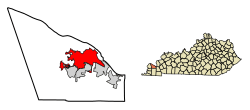
Location of Paducah in McCracken County, Kentucky
|
|||
| Country | United States | ||
| State | Kentucky | ||
| County | McCracken | ||
| Settled | c. 1821 | ||
| Established | 1830 | ||
| Incorporated | 1838 | ||
| Named for | The Comanche people | ||
| Government | |||
| • Type | City Manager | ||
| Area | |||
| • City | 20.75 sq mi (53.74 km2) | ||
| • Land | 20.30 sq mi (52.59 km2) | ||
| • Water | 0.45 sq mi (1.15 km2) | ||
| Elevation | 341 ft (104 m) | ||
| Population
(2020)
|
|||
| • City | 27,137 | ||
| • Estimate
(2023)
|
27,205 | ||
| • Density | 1,336.60/sq mi (516.06/km2) | ||
| • Metro | 103,481 | ||
| Demonym(s) | Paducahan | ||
| Time zone | UTC−6 (CST) | ||
| • Summer (DST) | UTC−5 (CDT) | ||
| ZIP Code |
42001-42002-42003
|
||
| Area codes | 270 & 364 | ||
| FIPS code | 21-58836 | ||
| GNIS feature ID | 0500106 | ||
Paducah (pronounced puh-DOO-kuh) is a city in McCracken County, Kentucky. It is located where the Tennessee and Ohio rivers meet. This location is about halfway between St. Louis, Missouri, and Nashville, Tennessee.
The city is a regional hub known for its rich history, arts, and culture. Many blocks in its downtown area are part of a historic district. Paducah is also famous for quilting and is known as "Quilt City, USA." As of the 2020 census, about 27,000 people live in Paducah.
Contents
History
How Paducah Got Its Name
The area was first settled by American pioneers around 1821 and was called "Pekin." In 1827, the famous explorer William Clark mapped out the town and gave it a new name: Paducah.
For a long time, people thought the name came from a Chickasaw leader named "Chief Paduke." However, historians now believe this story is a legend. They think Clark actually named the town after the Comanche people. Other tribes and settlers in the area knew the Comanche by the name Padoucas.
A City of Rivers and Railroads
Paducah officially became a town in 1830 and a city in 1838. Because it was on two major rivers, it became a busy port for steamboats. This helped the city's economy grow. Soon, railroads also came to Paducah, making it an important center for transportation.
Factories were built to make bricks and parts for trains. The Illinois Central Railroad built its largest locomotive workshop in the country here in 1924. This huge workshop employed thousands of people and helped the city thrive. Today, the shops are still used to repair and rebuild modern diesel locomotives.
The Civil War Years
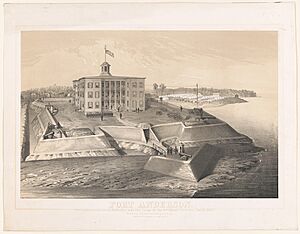
When the American Civil War began, Kentucky tried to stay neutral. But when Confederate (Southern) soldiers took over nearby Columbus, the Union (Northern) army, led by General Ulysses S. Grant, moved in and occupied Paducah. For most of the war, Paducah was a huge supply base for the Union army.
In 1862, General Grant issued General Order No. 11, which forced thirty Jewish families to leave their homes in Paducah. Grant made this order based on unfair beliefs about Jewish people. A local businessman named Cesar Kaskel sent a message to President Lincoln to complain. Lincoln agreed that the order was wrong and had it canceled.
In March 1864, Confederate General Nathan Bedford Forrest led a raid on Paducah. His goal was to gather supplies like food, horses, and ammunition. He successfully captured supplies and held the city for about ten hours before leaving.
The Great Flood of 1937
In January 1937, Paducah faced its worst natural disaster. After weeks of heavy rain, the Ohio River flooded. The water rose more than 10 feet above the flood stage. For almost three weeks, 27,000 people had to leave their homes.
The flood was so powerful that the city's levee (a dirt wall to hold back water) couldn't stop it. After the flood, the U.S. government helped build the concrete flood wall that protects the city today. You can still see marks on some downtown buildings showing how high the water reached.
Atomic City and Quilt City
In 1950, the U.S. government chose Paducah as the site for a uranium enrichment plant. This large factory, known as the Paducah Gaseous Diffusion Plant, played a role in producing fuel for nuclear power. The plant closed in 2013, and work began to clean up the site.
In 1991, the National Quilt Museum opened in Paducah. This helped the city become a world-famous center for quilting. Every year, thousands of people visit for the big quilt show. In 2013, Paducah was named a UNESCO Creative City for its focus on crafts and folk art.
Geography and Climate
Paducah is located in a part of the country with a humid subtropical climate. This means it has four distinct seasons. Summers are usually hot and humid, while winters are cool with a mix of rain, sleet, and snow.
Spring and fall are generally mild but can have big changes in weather. The city is also prone to flooding from the Ohio River, but the floodwall now offers protection.
| Climate data for Paducah, Kentucky (Barkley Regional Airport), 1991–2020 normals, extremes 1937–present | |||||||||||||
|---|---|---|---|---|---|---|---|---|---|---|---|---|---|
| Month | Jan | Feb | Mar | Apr | May | Jun | Jul | Aug | Sep | Oct | Nov | Dec | Year |
| Record high °F (°C) | 77 (25) |
78 (26) |
85 (29) |
90 (32) |
96 (36) |
108 (42) |
108 (42) |
106 (41) |
104 (40) |
96 (36) |
86 (30) |
77 (25) |
108 (42) |
| Mean maximum °F (°C) | 65.4 (18.6) |
70.7 (21.5) |
77.9 (25.5) |
84.0 (28.9) |
89.6 (32.0) |
95.0 (35.0) |
96.9 (36.1) |
96.4 (35.8) |
93.4 (34.1) |
86.5 (30.3) |
76.0 (24.4) |
67.0 (19.4) |
98.4 (36.9) |
| Mean daily maximum °F (°C) | 44.7 (7.1) |
49.7 (9.8) |
59.7 (15.4) |
70.4 (21.3) |
79.1 (26.2) |
87.1 (30.6) |
89.9 (32.2) |
89.5 (31.9) |
83.2 (28.4) |
71.8 (22.1) |
58.5 (14.7) |
48.3 (9.1) |
69.3 (20.7) |
| Daily mean °F (°C) | 36.0 (2.2) |
40.1 (4.5) |
49.0 (9.4) |
59.0 (15.0) |
68.4 (20.2) |
76.5 (24.7) |
79.7 (26.5) |
78.2 (25.7) |
71.0 (21.7) |
59.7 (15.4) |
48.0 (8.9) |
39.5 (4.2) |
58.8 (14.9) |
| Mean daily minimum °F (°C) | 27.3 (−2.6) |
30.5 (−0.8) |
38.3 (3.5) |
47.6 (8.7) |
57.7 (14.3) |
66.0 (18.9) |
69.4 (20.8) |
66.8 (19.3) |
58.9 (14.9) |
47.6 (8.7) |
37.5 (3.1) |
30.7 (−0.7) |
48.2 (9.0) |
| Mean minimum °F (°C) | 7.9 (−13.4) |
11.6 (−11.3) |
19.1 (−7.2) |
30.6 (−0.8) |
41.6 (5.3) |
53.2 (11.8) |
58.8 (14.9) |
55.7 (13.2) |
43.0 (6.1) |
30.4 (−0.9) |
21.0 (−6.1) |
12.7 (−10.7) |
4.0 (−15.6) |
| Record low °F (°C) | −15 (−26) |
−14 (−26) |
−6 (−21) |
21 (−6) |
32 (0) |
44 (7) |
47 (8) |
44 (7) |
34 (1) |
22 (−6) |
−3 (−19) |
−10 (−23) |
−15 (−26) |
| Average precipitation inches (mm) | 3.85 (98) |
3.94 (100) |
4.64 (118) |
5.17 (131) |
4.87 (124) |
4.51 (115) |
4.30 (109) |
3.11 (79) |
3.55 (90) |
3.99 (101) |
4.09 (104) |
4.30 (109) |
50.32 (1,278) |
| Average snowfall inches (cm) | 2.7 (6.9) |
3.0 (7.6) |
1.1 (2.8) |
0.0 (0.0) |
0.0 (0.0) |
0.0 (0.0) |
0.0 (0.0) |
0.0 (0.0) |
0.0 (0.0) |
0.1 (0.25) |
0.2 (0.51) |
1.8 (4.6) |
8.9 (23) |
| Average precipitation days (≥ 0.01 in) | 10.4 | 9.3 | 11.2 | 11.1 | 11.5 | 9.4 | 8.7 | 7.6 | 6.9 | 8.0 | 9.5 | 10.2 | 113.8 |
| Average snowy days (≥ 0.1 in) | 2.3 | 2.1 | 0.9 | 0.0 | 0.0 | 0.0 | 0.0 | 0.0 | 0.0 | 0.1 | 0.3 | 1.3 | 7.0 |
| Source: NOAA | |||||||||||||
Demographics
| Historical population | |||
|---|---|---|---|
| Census | Pop. | %± | |
| 1830 | 105 | — | |
| 1850 | 2,428 | — | |
| 1860 | 4,590 | 89.0% | |
| 1870 | 6,866 | 49.6% | |
| 1880 | 8,036 | 17.0% | |
| 1890 | 12,797 | 59.2% | |
| 1900 | 19,446 | 52.0% | |
| 1910 | 22,760 | 17.0% | |
| 1920 | 24,735 | 8.7% | |
| 1930 | 33,541 | 35.6% | |
| 1940 | 33,765 | 0.7% | |
| 1950 | 32,828 | −2.8% | |
| 1960 | 34,479 | 5.0% | |
| 1970 | 31,627 | −8.3% | |
| 1980 | 29,315 | −7.3% | |
| 1990 | 27,256 | −7.0% | |
| 2000 | 26,307 | −3.5% | |
| 2010 | 25,024 | −4.9% | |
| 2020 | 27,137 | 8.4% | |
| 2023 (est.) | 27,205 | 8.7% | |
| U.S. Decennial Census | |||
According to the 2020 U.S. Census, 27,137 people live in Paducah. The city is home to people from many different backgrounds.
| Race | Number | Percentage |
|---|---|---|
| White | 18,130 | 66.81% |
| Black or African American | 5,968 | 21.99% |
| Native American | 87 | 0.32% |
| Asian | 273 | 1.01% |
| Pacific Islander | 11 | 0.04% |
| Other/Mixed | 1,621 | 5.97% |
| Hispanic or Latino | 1,047 | 3.86% |
Economy
The rivers are still very important to Paducah's economy. Many barge companies that move goods on the river have their headquarters here. The city also has a dock where visiting boats can stop.
Some well-known companies, like Dippin' Dots ice cream, are based in Paducah. Healthcare, education, and retail stores are some of the biggest employers in the area. The National Weather Service also has a forecast office in Paducah that serves the surrounding region.
Arts and Culture
The Famous Floodwall Murals
Starting in 1996, artist Robert Dafford and his team began painting huge murals on the floodwall in downtown Paducah. There are now more than 50 murals. They show scenes from Paducah's history, including Native American life, steamboats, and the city's industries. It's like a giant outdoor art gallery.
More recently, other artists have added murals of award-winning quilts to the floodwall, celebrating the city's connection to the craft.
Lower Town Arts District
In 2000, Paducah started a program to encourage artists to move to the historic Lower Town neighborhood. The city offered incentives to artists who would buy and fix up the old Victorian-style homes. The program was a big success. It helped turn the neighborhood into a vibrant arts district and has been copied by other cities.
Music and Entertainment
The Luther F. Carson Center for the Performing Arts is a modern theater in downtown Paducah. It hosts Broadway shows, concerts, and other performances.
Paducah also has a rich musical history. In the past, many famous African-American musicians like Louis Armstrong and B.B. King performed in the city. Today, Paducah is the hometown of several musicians, including Steven Curtis Chapman, a very popular Christian music artist.
A fun fact is that Paducah is one of only two cities mentioned in the famous song "Hooray for Hollywood."
Sports
Paducah has a long history with minor league baseball. Several teams have called the city home over the years, including the Paducah Chiefs. They played at J. Polk Brooks Stadium, which is still used today for high school and college baseball games.
For racing fans, the Paducah International Raceway is a 3/8-mile racetrack that hosts motorsport events.
Government
Paducah has a council-manager form of government. The citizens elect a mayor and four commissioners. This group, called the Board of Commissioners, hires a professional city manager to run the day-to-day operations of the city. The mayor serves a four-year term, and the commissioners serve two-year terms.
Education
Most students in the city attend schools in the Paducah Public Schools district. This includes three elementary schools, one middle school, and Paducah Tilghman High School. Some parts of the city are served by the McCracken County Public Schools district, which has its own elementary, middle, and high schools.
For higher education, Paducah has a campus of West Kentucky Community and Technical College (WKCTC). It is considered one of the top community colleges in the nation. There are also Paducah campuses for the University of Kentucky's College of Engineering and Murray State University.
The McCracken County Public Library serves the city and county, offering books and other resources to everyone.
Infrastructure
Transportation
- Riverport: The city has a busy port on the river that helps move goods to and from the area.
- Airport: Barkley Regional Airport (PAH) offers flights to Charlotte, North Carolina, connecting Paducah to destinations around the world.
- Roads: Several major highways run through or near Paducah, including Interstate 24, which connects to St. Louis and Nashville. Other important roads are US 60, US 45, US 62, and US 68.
Notable people
Many famous people have come from Paducah. Here are a few:
- Alben W. Barkley, the 35th Vice President of the United States.
- Steven Curtis Chapman, a famous Christian music singer and songwriter.
- Sara Bradley, a chef who has appeared on the TV show Top Chef.
- Irvin S. Cobb, a well-known author and humorist from the early 20th century.
- Robert H. Grubbs, who won a Nobel Prize in Chemistry.
- Jeri Ryan, an actress known for her role in the TV series Star Trek: Voyager.
- Trevor "Ricochet" Mann, a professional wrestler in AEW.
- George Wilson, a former professional football player in the NFL.
See also
 In Spanish: Paducah (Kentucky) para niños
In Spanish: Paducah (Kentucky) para niños
- List of cities and towns along the Ohio River
- Paducah, Texas
- WIAR (Kentucky)



